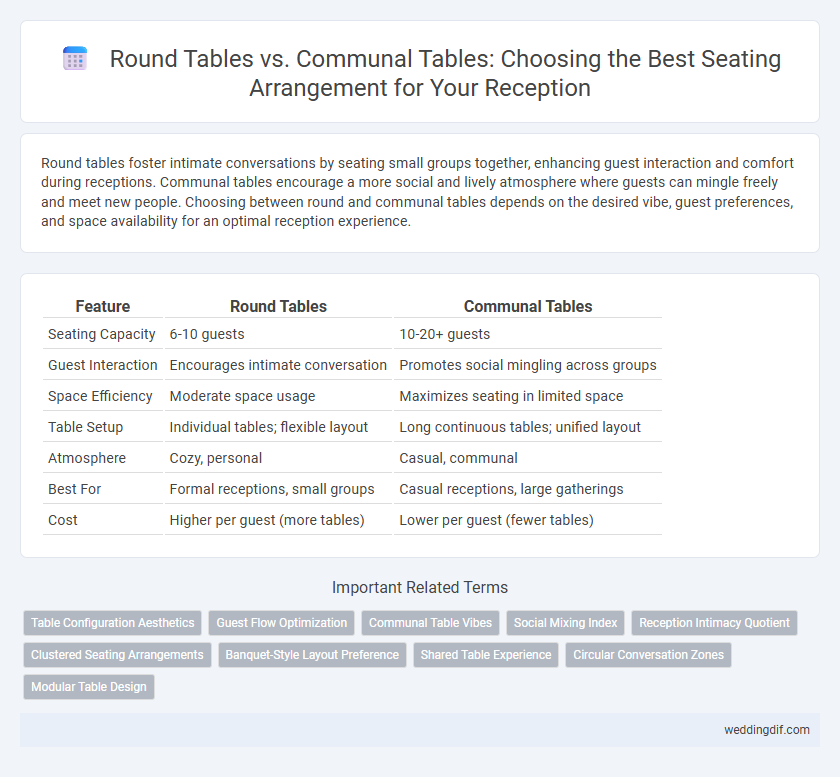Round tables foster intimate conversations by seating small groups together, enhancing guest interaction and comfort during receptions. Communal tables encourage a more social and lively atmosphere where guests can mingle freely and meet new people. Choosing between round and communal tables depends on the desired vibe, guest preferences, and space availability for an optimal reception experience.
Table of Comparison
| Feature | Round Tables | Communal Tables |
|---|---|---|
| Seating Capacity | 6-10 guests | 10-20+ guests |
| Guest Interaction | Encourages intimate conversation | Promotes social mingling across groups |
| Space Efficiency | Moderate space usage | Maximizes seating in limited space |
| Table Setup | Individual tables; flexible layout | Long continuous tables; unified layout |
| Atmosphere | Cozy, personal | Casual, communal |
| Best For | Formal receptions, small groups | Casual receptions, large gatherings |
| Cost | Higher per guest (more tables) | Lower per guest (fewer tables) |
Introduction: Choosing the Right Reception Table Style
Round tables foster intimate conversations by seating smaller groups around a circular arrangement, enhancing guest interaction and comfort during receptions. Communal tables encourage a more open and inclusive atmosphere, allowing larger groups to socialize together and promote a sense of community. Selecting the right table style depends on overall event goals, guest list size, and the desired ambiance for the reception.
Round Tables: Classic Choice for Intimate Gatherings
Round tables create a cozy atmosphere by encouraging face-to-face interaction, making them ideal for receptions centered on intimate conversations. Their classic design accommodates small groups effectively, fostering connection among guests. This seating arrangement enhances guest experience by promoting inclusivity and balanced communication during events.
Communal Tables: Fostering Community and Connection
Communal tables at receptions encourage interaction and bonding by seating guests closely together, creating a warm and inviting atmosphere. This seating arrangement promotes meaningful conversations and a sense of unity that round tables, with their smaller, segmented groups, often lack. Event planners choose communal tables to enhance social dynamics and foster a genuine community experience among attendees.
Guest Experience: Comfort and Flow
Round tables create intimate settings that enhance guest comfort by allowing easier conversation among smaller groups, while communal tables encourage social interaction and a lively atmosphere. The flow around round tables is smoother with more space for guests to move freely, reducing congestion during receptions. Communal tables can sometimes restrict movement and cause discomfort due to shared seating, potentially impacting the overall guest experience negatively.
Aesthetics: Visual Impact and Decor Flexibility
Round tables create a classic and intimate aesthetic, allowing for personalized centerpiece arrangements that enhance visual appeal and complement various decor themes with ease. Communal tables offer a sleek, modern look that emphasizes togetherness and open interaction, often providing a minimalist canvas adaptable for seasonal or thematic decor changes. Both options significantly impact reception ambiance, with round tables supporting intricate decor elements and communal tables fostering a spacious, cohesive visual flow.
Venue Logistics: Space Utilization and Layout
Round tables optimize space utilization by allowing guests to be seated in clusters, promoting conversation while maintaining clear pathways for servers and movement. Communal tables maximize seating capacity in narrow or elongated venues by aligning guests in a linear arrangement, though they may limit intimate interactions. Venue layout considerations should balance table size, spacing requirements, and circulation flow to enhance comfort and operational efficiency during the reception.
Seating Arrangements: Ease of Planning
Round tables simplify seating arrangements by clearly defining guest groups, making it easier to plan interactions and ensure balanced conversation flow during receptions. Communal tables encourage a more informal and social atmosphere but require careful consideration to avoid overcrowding and to maintain guest comfort. Choosing between round and communal tables impacts not only planning efficiency but also guest experience and space utilization.
Social Dynamics: Interaction and Atmosphere
Round tables foster intimate conversations by allowing guests to face each other directly, enhancing social interaction and creating a cozy atmosphere. Communal tables encourage a more dynamic and inclusive environment, promoting mingling among larger groups and spontaneous connections across diverse guests. The choice between round and communal tables significantly influences the overall energy and guest engagement during the reception.
Budget Considerations: Costs and Efficiency
Round tables typically incur higher rental and setup costs due to the need for multiple tables and centerpieces, increasing overall budget demands. Communal tables offer cost efficiency by reducing the number of tables and decorations required, streamlining event coordination and minimizing labor expenses. Choosing communal tables enhances space utilization and often lowers catering service charges by simplifying menu distribution and service flow.
Final Tips: Making the Best Table Choice for Your Wedding
Choosing between round tables and communal tables for your wedding reception depends on the desired guest interaction and space efficiency. Round tables encourage intimate conversation among smaller groups, ideal for formal settings, while communal tables foster a lively, inclusive atmosphere suitable for casual or rustic-themed weddings. Prioritize guest comfort and venue layout to ensure smooth movement and a memorable dining experience.
Round Tables vs Communal Tables for Reception. Infographic

 weddingdif.com
weddingdif.com